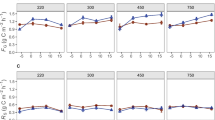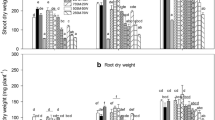Summary
The amounts of C and N that pass through the nematode biomass in four cropping systems, barley without and with N fertilization, grass ley and lucerne, has been estimated. The nematodes were sampled at the field site of a Swedish integrated research project “Ecology of Arable Land: The Role of Organisms in Nitrogen Cycling”. The nematode biomass was lower (200 mg dry weight m−2) in the annual (barley) than in the perennial (grass and lucerne, 350 mg dry weight m−2) crops. For respiration, the nematodes used 4–71 O2m−2 year−1 corresponding to C liberation of 1.3%–2.0% of the carbon input to the soil. A higher relative contribution by bacterial-feeding nematodes to the C and N fluxes and a higher turnover rate of the nematode biomass is an indication of more rapid nutrient circulation in the annual than in the perennial cropping systems.
Similar content being viewed by others
References
Anderson RV, Coleman DC, Cole CV (1981) Effects of saprotrophic grazing on net mineralization. In: Clark FE, Rosswall T (eds) Terrestrial nitrogen cycles. Ecol Bull (Stockh) 33:201–216
Andádssy I (1956) Die Rauminhalts- und Gewichtsbestimmung der Fadenwürmer (Nematodes). Acta Zool Acad Sci Hung 2:1–15
Andrén O, Hansson A-C, Pettersson R (1987) Contributions to soil organic matter from four arable crops. Intecol Bull 1987:15 (in press)
Bornebusch CH (1930) The fauna of forest soil. Forstl Forsoegsvaes Dan 11:1–224
Boström S, Sohlenius B (1986) Short-term dynamics of nematode communities in arable soil — Influence of a perennial and an annual cropping system. Pedobiologia 29:345–357
Goodell PB, Ferris H (1981) Sample optimization for five plantparasitic nematodes in an alfalfa field. J Nematol 13:304–313
Hansson A-C, Steen E (1984) Methods of calculating root production and nitrogen uptake in an annual crop. Swedish J Agric Res 14:191–200
Heilbrunn LV (1947) An outline of general physiology, 2nd edn. Saunders, Philadelphia London
Hendrix PF, Parmelee RW Crossley DA Jr, Coleman DC, Odum EP, Groffman PM (1986) Detritus food webs in conventional and no-tillage agroecosystems. BioScience 36:374–380
Ingham RE, Detling JK (1984) Plant-herbivore interactions in a North American mixed-grass prairie III. Soil nematode populations and root biomass on Cynomys ludovicianus colonies and adjacent uncolonized areas. Oecologia 63:307–313
Klekowski RZ, Wasilewska L, Paplinska E (1972) Oxygen consumption by soil-inhabiting nematodes, Nematologica 18:391–403
Nicholas WL (1984) The biology of free-living nematodes, 2nd edn. Clarendon Press, Oxford
Nielsen CO (1948) An apparatus for quantitative extraction of nematodes and rotifers from soil and moss. Nat Jutl 1:271–278
Nielsen CO (1961) Respiratory metabolism of some populations of enchytraeid worms and freeliving nematodes. Oikos 12:17–35
Parmelee RW, Alston DG (1986) Nematode trophic structure in conventional and no-tillage agroecosystems. J Nematol 18:403–407
Persson T (1983) Influence of soil animals on nitrogen mineralisation in a northern Scots pine forest. In: Lebrun P, André HM, de Medts A, Grégoire-Wibo C, Wauthy G (eds) New trends in soil biology. Université Catholique de Louvain, Louvain-la-Neuve, pp 117–126
Persson T, Bååth E, Clarholm M, Lundkvist H, Söderström BE, Sohlenius B (1980) Trophic structure, biomass dynamics and carbon metabolism of soil organisms in a Scots pine forest. In: Persson T (ed) Structure and function of northern coniferous forests — An ecosystem study. Ecol Bull (Stockh) 32:419–459
Petrusewicz K, Macfadyen A (1970) Productivity of terrestrial animals — Principles and methods. IBP Handbook No. 13. Blackwell, Oxford Edinburgh
Popovici I (1984) Nematode abundance, biomass and production in a beech forest ecosystem. Pedobiologia 26:205–219
Reichle DE (1977) The role of soil inverbrates in nutrient cycling. In: Lohm U, Persson T (eds) Soil organisms as components of ecosystems. Ecol Bull (Stockh) 25:145–156
Rosswall T, Paustian K (1984) Cycling of nitrogen in modern agricultural systems. Plant Soil 76:3–21
Ryszkowski L (1985) Impoverishment of soil fauna due to agriculture. In: Cooley JH (ed) Soil ecology and management. Intecol Bull 12:7–17
Schnürer J (1985) Fungi in arable soil. Their role in carbon and nitrogen cycling. Ph D Dissertation, Rep 29 Dept Microbiol, Swedish Univ Agric Sci, Uppsala
Schnürer J, Clarholm M, Rosswall T (1986) Fungi, bacteria and protozoa in soil from four arable cropping systems. Biol Fertil Soils 2:119–126
Sohlenius B (1973) Influence of food supply on population structure and length distribution in Acrobeloides nanus (Nematoda: Cephalobidae). Pedobiologia 13:205–213
Sohlenius B (1979) A carbon budget for nematodes, rotifers and tardigrades in a Swedish coniferous forest soil. Holarct Ecol 2:30–40
Sohlenius B (1980) Abundance, biomass and contribution to energy flow by soil nematodes in terrestrial ecosystems. Oikos 34:186–194
Sohlenius B, Sandor A (1987) Vertical distribution of nematodes in arable soil under grass (Festuca pratensis) and barley (Hordeum distichum). Biol Fertil Soils 3:19–25
Sohlenius B, Boström S, Sandor A (1987) Long-term dynamics of nematodes in arable soil under four cropping systems. J Appl Ecol 24:131–144
Steen E, Jansson P-E, Persson J (1984) Experimental site of the “Ecology of arable land” project. Acta Agric Scand 34:153–166
Testerink GJ (1981) Starvation in a field population of litter-inhabiting Collembola. Methods for determining food reserves in small arthropods. Pedobiologia 21:427–433
Wasilewska L (1974) Number, biomass and metabolic activity of nematodes of two cultivated fields in Turew. Zesz Probl Postepow Nauk Roln 154:419–442
Wasilewska L (1979) The structure and function of soil nematode communities in natural ecosystems and agrocenoses. Pol Ecol Stud 5:97–145
Wasilewska L, Paplinska E (1975) Energy flow through the nematode community in a rye crop in the region of Poznan. Pol Ecol Stud 1:75–82
Wright DJ, Newall DR (1976) Nitrogen excretion, osmotic and ionic regulation in nematodes. In: Croll NA (ed) The organization of nematodes. Academic Press, London New York San Francisco, pp 163–210
Yeates GW (1979) Soil nematodes in terrestrial ecosystems. J Nematol 11:213–229
Author information
Authors and Affiliations
Rights and permissions
About this article
Cite this article
Sohlenius, B., Boström, S. & Sandor, A. Carbon and nitrogen budgets of nematodes in arable soil. Biol Fert Soils 6, 1–8 (1988). https://doi.org/10.1007/BF00257912
Received:
Issue Date:
DOI: https://doi.org/10.1007/BF00257912




